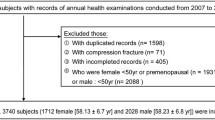Abstract
The aim of this study was to determine age-specific bone mineral density (BMD) at various skeletal regions in a native Chinese reference population, and to explore the differences in the diagnosis of primary osteoporosis and estimated prevalence of osteoporosis based on both Chinese criteria (BMD of subjects, 25% lower than the peak BMD) and WHO criteria (BMD of subjects, 2.5 SD [T-score ≤ −2.5] lower than the young adult mean [YAM]). There were 3406 subjects in our female reference population, ranging in age from 10 to 90 years. A dual-energy X-ray absorptiometry (DXA) fan-beam bone densitometer (Hologic QDR 4500A) was used to measure the BMD in subjects at the posteroanterior (PA) spine (L1–L4), supine lateral spine (L2–L4 including areal BMD [aBMD] and volumetric BMD [vBMD]), hip (including femoral neck and total hip), and radius + ulna ultradistal (R + UUD) of the forearm. Cross-sectional data analysis in stratified 5-year age intervals revealed that the peak BMD (PBMD) at various skeletal regions occurred within the age range of 30–44 years, with PBMD at the lateral spine and femoral neck occurring at 30–34 years, posteroanterior spine and total hip at 35–39 years, and ultradistal forearm at 35–44 years. The reference values of BMD (PBMD) calculated using Chinese criteria for the diagnosis of primary osteoporosis were significantly higher than the young adult mean (YAM) using WHO criteria for all skeletal regions except for the total hip, at a range of 0.9%–3.8% higher. The BMD cutoff values using Chinese criteria for the diagnosis of osteoporosis were 3.7%–10.9% higher than those using WHO criteria for various skeletal regions. The prevalence rate of primary osteoporosis according to Chinese criteria in subjects ranging from 50 to 90 years was 41.5% at the PA spine, 53.9% at the lateral spine, 34.2% at the femoral neck, 30.7% for total hip, and 51.4% at R + UUD; while according to WHO criteria, this rate was 32.1% at the PA spine, 34.9% at the lateral spine, 16.3% at the femoral neck, 18.9% for total hip, and 45.2% at R + UUD. The prevalence of primary osteoporosis according to both criteria varied with the age and skeletal region of the subjects. The prevalence of primary osteoporosis using Chinese criteria, compared with WHO criteria was 31% higher at the lumbar spine, 109% higher at the femoral neck, and 14% higher at the ultradistal forearm. In conclusion, PBMD occurs in the age range of 30–44 years in native Chinese females. The BMD reference values, BMD cutoff values, and prevalence of primary osteoporosis determined by Chinese criteria are all higher than those determined by the WHO criteria; thus, the application of Chinese criteria may overestimate the number of patients with primary osteoporosis.
Similar content being viewed by others
Author information
Authors and Affiliations
Corresponding author
About this article
Cite this article
Wu, XP., Liao, EY., Zhang, H. et al. Determination of age-specific bone mineral density and comparison of diagnosis and prevalence of primary osteoporosis in Chinese women based on both Chinese and World Health Organization criteria. J Bone Miner Metab 22, 382–391 (2004). https://doi.org/10.1007/s00774-004-0499-x
Received:
Accepted:
Issue Date:
DOI: https://doi.org/10.1007/s00774-004-0499-x




